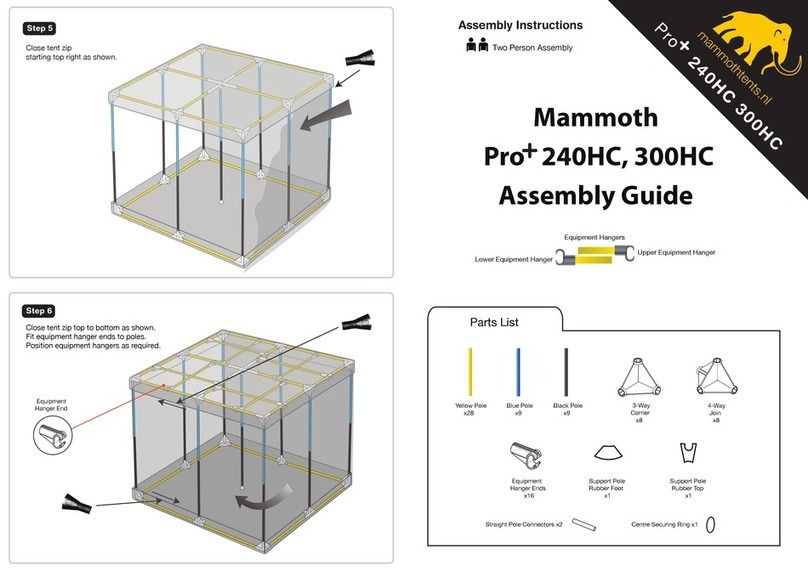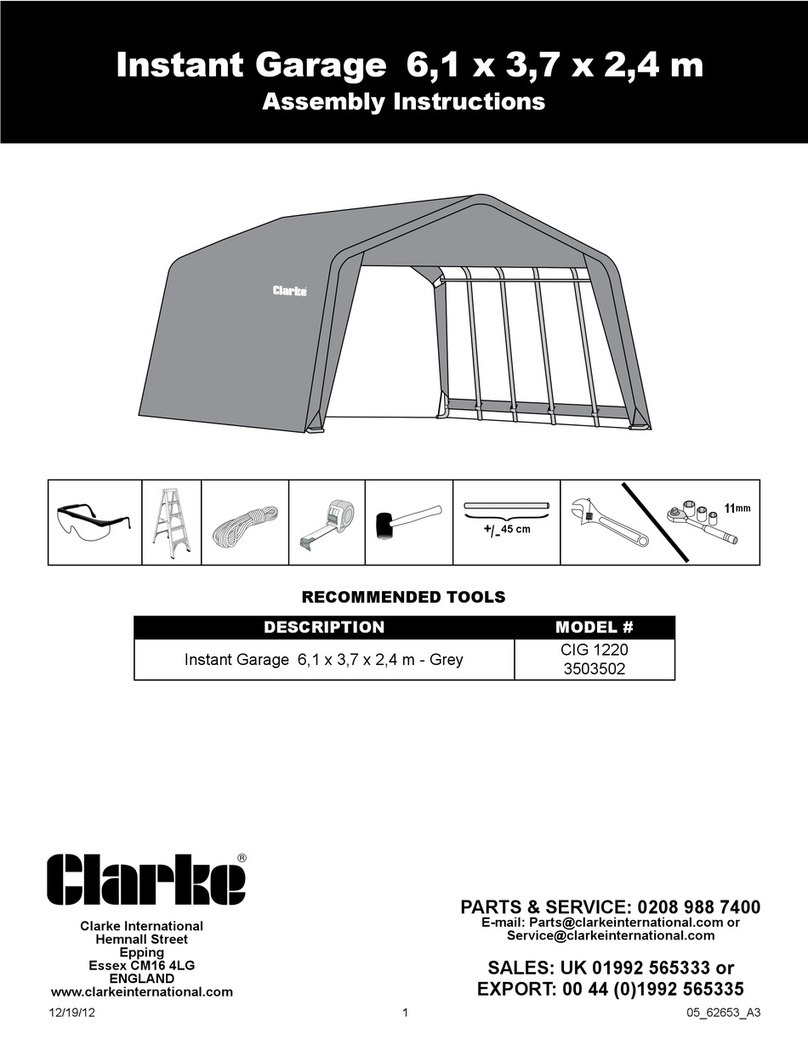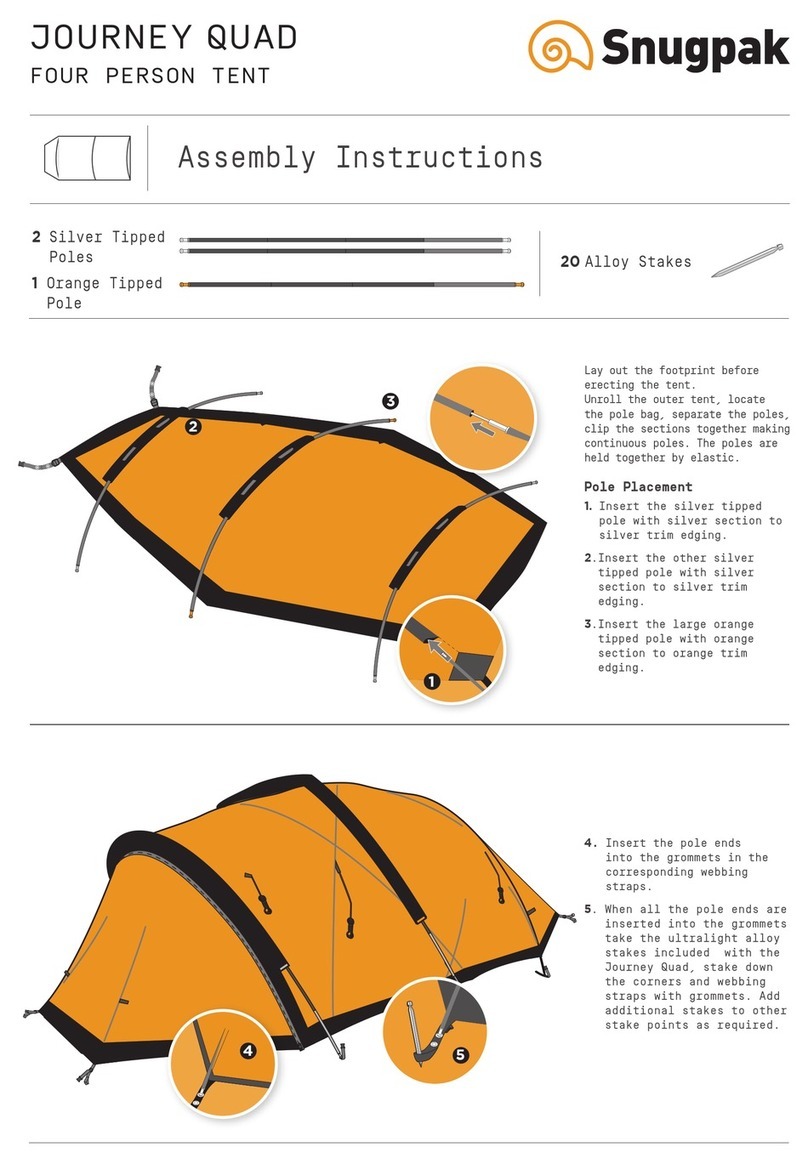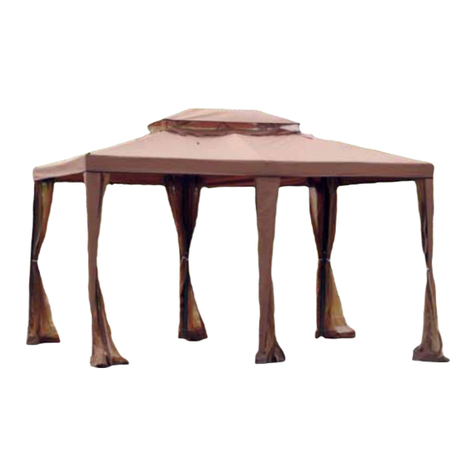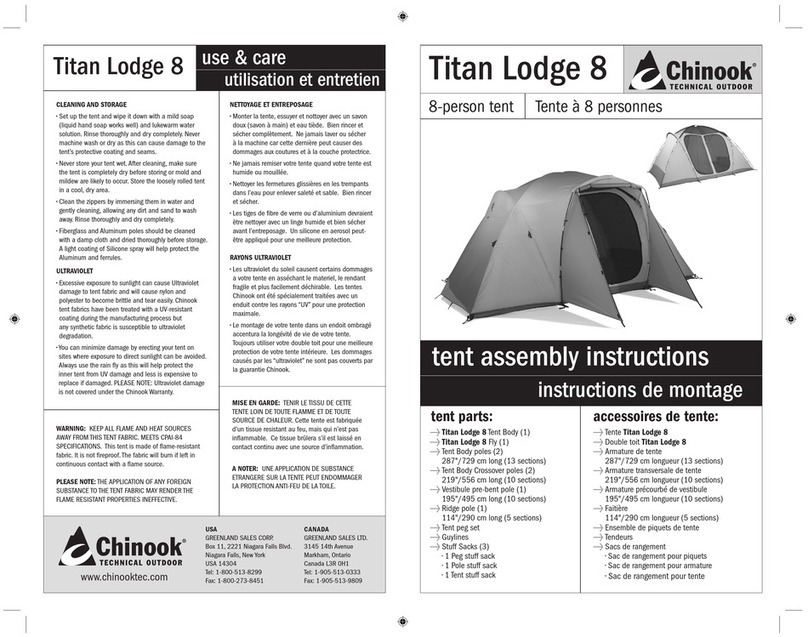Mountain HardWear User manual

TENT OWNER’S MANUAL

Contents
Selecting A Site . . . . . . . . . . . . . . . . . . . . . . . 2
Footprints . . . . . . . . . . . . . . . . . . . . . . . . . . . . 2
Caring For Your Tent On The Trail . . . . . . . . . 3
Stormproofing Your Tent . . . . . . . . . . . . . . . . 3
Guy-Out Cord . . . . . . . . . . . . . . . . . . . . . . . . . 4
Internal Guy System . . . . . . . . . . . . . . . . . . . . 4
Internal Guy System cont. . . . . . . . . . . . . . . . 5
Ultraviolet (UV) Light . . . . . . . . . . . . . . . . . . . 5
Food Storage . . . . . . . . . . . . . . . . . . . . . . . . . 6
Tent Pole Care . . . . . . . . . . . . . . . . . . . . . . . . . 6
Field Repairs . . . . . . . . . . . . . . . . . . . . . . . . . . 7
Poles . . . . . . . . . . . . . . . . . . . . . . . . . . . . . . . . 7
Zippers . . . . . . . . . . . . . . . . . . . . . . . . . . . . . . . 7
Tears and Other Damage . . . . . . . . . . . . . . . . 8
Caring For Your Tent At Home . . . . . . . . . . . 8
Seam Sealing The Tent Body . . . . . . . . . . . . . 8
Seam Sealing the Tent Fly . . . . . . . . . . . . . . . 9
Cleaning Your Tent . . . . . . . . . . . . . . . . . . . . . 9
Storing Your Tent . . . . . . . . . . . . . . . . . . . . . . 9
What Does Your Tent Weigh? . . . . . . . . . . . . 9
Low Impact Camping . . . . . . . . . . . . . . . . . . 10
Tent Accessories . . . . . . . . . . . . . . . . . . . . . . 10
Mountain Hardwear Lifetime Warranty . . . 11
Repairs . . . . . . . . . . . . . . . . . . . . . . . . . . . . . 11
WARNING!!! PLEASE READ! . . . . . . . . . . . . 12

1
Thank you for choosing a Mountain Hardwear
tent. We take pride in making lightweight
durable shelters for outdoor enthusiasts.
Please take the time to read this user manual and
“test pitch” your new tent before taking it into the
wilderness.
WARNING!!!
For your safety, please read and understand the
warning on page 12. If you do not understand any
part of the warning call Mountain Hardwear at
800-330-6800 or 510-558-3000 before using the tent.

2
Selecting A Site
Choose a site that is level, clear of sharp stones and other
debris, is sheltered from the wind, and will drain when
it rains. You may wish to face your tent south or east to
catch the morning sun. Do not pitch your tent under
trees, in water drainages, or on ridge tops.
Even though most of our tents are free-standing, we rec-
ommend that you always stake out your tent to prevent
it from flying away in a gust of wind. Secure all pull-outs
(webbing loops located on the perimeter of the tent).
Cinch all webbing adjustments tightly.
Footprints
We recommend using a Mountain Hardwear footprint
to protect the floor of your tent. Footprints are designed
to fit precisely under each tent style and shield the tent
floor from sharp twigs, rocks, tree sap, and the like. Foot-
prints can be purchased at your Mountain Hardwear
dealer.
MOUNTAIN HARDWEAR TENT FOOTPRINT

3
CARING FOR YOUR TENT ON THE TRAIL
Stormproofing Your Tent
All Mountain tents:
1.Using a 3 hole line tightener and cord (Fig. 2a). Adjust
the tension by sliding the tightener to either tighten
or loosen the line as shown in Fig. 2b.
Superlight and Expedition tents:
Using Line-Lok™ cord cleats. Use cord 2 – 5 mm
(5/64 3/16 inch) in diameter.
1. Feed cord through cord cleat and secure (Fig.1a).
(code and cleat should appear as in Fig.1b)
2. To tension the cord, slide the cleat upward (Fig.1c).
3. To release tension, pull the cords apart (Fig. 1c).
FIGURE 1A FIGURE 1B FIGURE 1C FIGURE 1D
FIGURE 2A FIGURE 2B

4
Expedition tents:
Guy-Out Cord
Guy-out loops are sewn to the outside of the flysheet. On
the inside of the flysheet (opposite of where the guy-out
loops are sewn) are clips (Fig. 3). Attach these clips to the
tent pole and then attach a cord to the guy-out loop and
anchor the tent properly. Make sure you tie your guy-out
cord to objects (tent stakes, rocks, snow pickets, etc.)
which will hold the tent in a strong wind.
Internal Guy System
To further stormproof your tent add two internal guy
systems to the inside of your tent by using the cord and
cord cleats provided and the webbing loops sewn into
the interior walls and roof. Join two pieces of 96” cord,
forming one long cord. Tie one end of the cord to
point B (Fig. 4a) at one inside corner of the tent, and
thread the free end through the webbing loops at points
C, D, and E. Now thread the free end through a cord
cleat (Fig. 1 previous page) and then guide it through the
webbing loop at point F. Secure the free end of the cord
to the line tightener.
With the second long cord and cleat, follow the same
procedure for points G, H, D, I, and J. Adjust these two
internal guy systems as conditions require (Fig. 4b).
FIGURE 3

5
Internal Guy System cont.
Ultraviolet (UV) Light
Ultraviolet light degrades lightweight tent fabric (and
almost any synthetic material). UV light will cause the
fabric to fade, lose strength, and eventually disintegrate.
The amount of UV damage is directly related to the
fabric’s exposure to the sun and the altitude at which the
tent is pitched. If it is left pitched during the day, high-
altitude exposure can damage a tent beyond use within
a month. The best way to prolong the life of your tent is
to keep it out of the sun. Pitch your tent in a shady spot
whenever possible. By striking (taking your tent down)
in the morning and pitching your tent late in the day,
your tent will last many years.
FIGURE 4A
FIGURE 4B

6
Food Storage
Never store food in your tent. Animals will often tear or
bite their way into a tent to get your food.
Tent Pole Care
When assembling the poles, never allow the pole
sections to snap against each other. Always make sure
that all pole sections are fully engaged before bend-
ing (fig. 5). Keep the poles clean and free of silt, sand,
and salt, taking special care with the tips as they are
not anodized and can corrode. When disassembling
your poles, always start from the center, then work your
way to the tips. This allows the elastic cord to be evenly
stretched, an important factor when the poles are stored
disassembled for a long period of time.
Using tent poles near saltwater. Special care should
be used when storing or using aluminum tent poles in
saltwater environments for an extended time. Clean the
tent poles with fresh water or for additional protection
use an aluminum lubricant such as Boeshield. You can
find out more about Boeshield at www.Boeshield.com.
The use of aluminum lubricants is not necessary under
most conditions, as Easton aluminum poles come hard
anodized from the factory.
FIGURE 5

7
FIELD REPAIRS
Poles
If you break a tent pole, you can temporarily repair
the break by splinting the pole with a short aluminum
repair sleeve. The aluminum repair sleeve is fitted over
the broken pole section (Fig. 6) and taped (or wedged)
into place. Ski pole repair sleeves, tent stakes and even
branches can be used to splint broken tent tubes.
Zippers
One of the keys to zipper longevity is to keep them away
from sand and grit. When pitching your tent, be care-
ful to keep the door and window zippers out of the dirt.
Never step on the zipper. Keep zippers clean by washing
them (at home) with a garden hose and pressure nozzle.
Most zipper failures result from wear to the coating on
the inside of the zipper slider (the metal toggle). Once
that coating wears off, the metal abrades rapidly, and
the zipper slider no longer joins the continuous plastic
coils securely. The plastic coils then tend to separate
behind the zipper slider. You can replace a worn out zip-
per slider with our patented Zipper Repair Clamp. The
Zipper Repair Clamp (Fig. 7) is available from your local
Mountain Hardwear dealer.

8
Tears and Other Damage
Small holes and tears can be repaired in the field using
a needle and thread, adhesive repair tape, or liquid ure-
thane (Mcnett™ Seam Grip). Field repairs do not void
the tent’s warranty.
CARING FOR YOUR TENT AT HOME
Never pack or store your tent if it is dirty and/or damp.
If you do so, mildew can form and ruin the waterproof
coating on your tent. Mildew will cause your tent to
smell and can eventually delaminate and damage the
polyurethane coating. This will cause your tent to leak.
There is no cure for mildew damage. Prolonged moisture
on the polyurethane coating (storing the tent wet for
more than a few days) can cause hydrolysis. The coating
becomes soft and sticks to itself, peeling from the fabric
which will lead to leakage. Mildew damage and hydroly-
sis are not covered under our Lifetime Warranty.
Seam Sealing The Tent Body
If your tent will be subject to prolonged rainfall or a
persistantly wet environment, the bias bound floor
perimeter seam (where the sidewall meets the floor) on
the tent body must be sealed. Do not seam seal the tent
canopy or zippers. Pitch the tent in a well ventilated area
(preferably out of doors and in the shade). Make sure the
tent is clean, dry, and taut. Stake out the tent floor. Never
seam seal in cold, damp (humid) environments. Seal the
inner, coated (shiny) side of the fabric only. Seam sealer
does not adhere as well to the uncoated side because
the water repellent finish is applied to that side. Apply
several thin coats instead of one thick coat. Work the
seam sealer thoroughly into the floor perimeter seam
by applying pressure and brushing the liquid back and
forth. Follow the drying instructions on the seam sealant
tube carefully to prevent damaging your tent.

9
Seam Sealing the Tent Fly
The flysheet is factory seam sealed with hot tape. For
most weather conditions, no further seam sealing is nec-
essary. However, if it will be subject to prolonged rainfall
or a persistantly wet environment, we recommend that
you seam seal certain points on the inside of the fly. Lay
the flysheet inside out on the pitched tent. The coated
(shiny) side of the fabric should be facing out. Seam seal
all points where webbing or Velcro are sewn into or on a
seam. Work the sealer into and around these attachment
points using the techniques described in the paragraph
above. Follow the drying instructions on the seam seal-
ant tube carefully.
Cleaning Your Tent
Never machine wash or machine dry your tent. For
localized cleaning, use a sponge with warm water. When
cleaning the entire tent, wash in a tub (bathtub) of cold
water. Never use hot water, bleach, dish-washing liquid,
pre-soaking solutions, or spot removers. If you use soap,
always use a non-detergent soap. Dry your tent by pitch-
ing it in the shade or by line drying only. Never machine
dry your tent.
Storing Your Tent
Store your tent in a cool, dry environment. Pack the tent
loosely, and, if possible, leave the shock-corded poles
completely or partially assembled.
What Does Your Tent Weigh?
The weight of a tent is one of the most important factors
used by consumers when making purchasing decisions.
In the past, tent manufacturers have independently
determined which components they included in their

10
publicized weights. This makes comparing tent weights
between companies difficult. Mountain Hardwear pro-
vides the minimum tent weights and the packaged tent
weights.
Minimum Weight: Minimum Weight is the total weight
of the tent body, flysheet, and poles only; it is the weight
of the bare essentials. This is the figure most often used
for comparative purposes when purchasing a tent.
Packaged Weight (Also known as Trail Weight): Packaged
Weight includes everything that comes with the tent
when the tent is purchased (less any shipping contain-
er): tent body, flysheet, poles, tent stuff sack, pole sack,
peg sack, pegs, cord, line tighteners, user manual, repair
items and any other items included by the manufacturer
other than shipping materials.
Low Impact Camping
Camp away from streams, lakes and trails. Use biode-
gradable soaps sparingly, 200 feet or more from water.
Pack out what you bring in. Please call 800.332.4100 for
more information on LEAVE NO TRACE camping.
Tent Accessories
Mountain Hardwear offers the following accessories
for your tent:
• Aluminum Y-Pegs: rigid, durable, made from 7075 T6
Easton aluminum, the strongest pegs available.
• Snow and Sand Anchors: a bombproof way to guy-out
your tent in snow or sand.
• Tent Footprint: a custom ground tarp that fit precisely
beneath your tent’s floor.
• Gear Loft: a mesh shelf that provide extra storage in
the upper region of your tent.
These accessories are available at your
Mountain Hardwear dealer.

11
Mountain Hardwear Lifetime Warranty
Mountain Hardwear guarantees that the materials and
workmanship in every product we make will stand up
to the use for which it was designed. This warranty does
not cover damages caused by improper care, accidents
or natural breakdown of materials over extended time
and use. All products should be returned to us for evalu-
ation and will be repaired or replaced at our discre-
tion. Damages due to accident or improper care will be
repaired at a reasonable rate.
Repairs
All items covered under our warranty will be repaired or
replaced (at our discretion) at no charge. We can provide
cost estimates for repairing damaged items not covered
by our warranty. California State Law requires that all
items which are to be repaired must be clean. We do
not have the facilities to wash tents. Soiled tents will be
returned to the owner for cleaning before the item can
be repaired.
The Mountain Hardwear Warranty Department can be
reached at:
Mountain Hardwear
4911 Central Ave
Richmond CA 94804
510-558-3000 • 800-953-8398
warranty@mountainhardwear.com
www.mountainhardwear.com

12
WARNING!!! PLEASE READ!
FIRE: All Mountain Hardwear tents are made of flame-retardant
materials, but most nylon and polyester fabric will melt or burn
when exposed to high heat or an open flame. Never place your
stove, hibachi, campfire, or other heat source in or near your
tent. We recommend that you always position your tent upwind
of a camp fire. This will reduce the chances of having a flying
ember land on your tent. Never use a candle as a light source
inside your tent.
Do not cook with, light, or refuel a stove (or any other heat
source) inside your tent or in your vestibule! Asphyxiation and
serous injury are possible! Stoves, hibachis, lanterns and heat-
ers can malfunction (operator error is also possible) and can
start a fire that will spread too rapidly for occupants to escape a
tent. Using combustible materials and/or petroleum-based fu-
els can increase the carbon dioxide levels within a tent enough
to cause asphyxiation to the occupants.
Maintain adequate ventilation inside your tent at all times.
Never seal your tent up completely. Always leave a small part
of a window open. Never allow your tent to become buried in
snow past the bottom of the flysheet since this may allow the
carbon dioxide and carbon monoxide levels inside the tent to
become dangerously high.
Campsite selection: Consider the possibility of falling rocks or
tree limbs, lightning strikes, flash floods, avalanches, strong
winds, and other objective hazards when choosing a campsite.
Properly stake and guy out your tent at all times. Lightweight
tents are very strong for their weight and can withstand severe
weather when properly staked out and guyed out. Always use
the proper tent stakes to anchor your tent and guy-lines to the
ground. Use the internal guy system (included with all four-
season tents) during severe weather. You may wish to purchase
more and/or different tent stakes and nylon cord, depending
on when and where you intend to use your tent. It is impossible
for Mountain Hardwear to include anchors for every possible
environmental condition.
IF YOU DO NOT UNDERSTAND ANY PART OF THIS
WARNING CALL MOUNTAIN HARDWEAR AT 800-953-8375
BEFORE USING THE TENT.

13
TENTE – NOTICE
D’UTILISATION

14
Sommaire
Sélection d’un emplacement . . . . . . . . . . . . 16
Tapis de sol . . . . . . . . . . . . . . . . . . . . . . . . . . 16
Entretien de la tente en randonnée . . . . . . 17
Protection de la tente contre les orages . . 17
Hauban . . . . . . . . . . . . . . . . . . . . . . . . . . . . . 18
Système de haubanage interne. . . . . . . . . . 18
Système de haubanage interne (suite) . . . . 19
Rayonnement ultraviolet (UV). . . . . . . . . . . 19
Entreposage des aliments . . . . . . . . . . . . . . 20
Entretien des mâts de tente . . . . . . . . . . . . 20
Réparations sur le terrain . . . . . . . . . . . . . . 21
Mâts . . . . . . . . . . . . . . . . . . . . . . . . . . . . . . . 21
Fermetures-éclair . . . . . . . . . . . . . . . . . . . . . 21
Déchirures et autres dommages . . . . . . . . . 22
Entretien de la tente chez soi . . . . . . . . . . . 22
Imperméabilisation des coutures du corps de
tente . . . . . . . . . . . . . . . . . . . . . . . . . . . . . . . 22
Imperméabilisation des coutures du double
toit de la tente . . . . . . . . . . . . . . . . . . . . . . . 23
Nettoyage de la tente . . . . . . . . . . . . . . . . . 23
Entreposage de la tente . . . . . . . . . . . . . . . . 23
Poids de la tente . . . . . . . . . . . . . . . . . . . . . 23
Camping écologique . . . . . . . . . . . . . . . . . . 24
Accessoires de tente . . . . . . . . . . . . . . . . . . 24
Garantie à vie Mountain Hardwear . . . . . . 25
Réparations . . . . . . . . . . . . . . . . . . . . . . . . . 25
AVERTISSEMENT !!! À LIRE ! . . . . . . . . . . . 26

15
Merci d’avoir sélectionné une tente
Mountain Hardwear. Nous sommes
fiers de fabriquer des abris durables
légers pour les fanatiques d’activités de plein air.
Prendre quelques minutes pour lire cette notice
d’utilisation et essayer de « planter » la nouvelle
tente avant de l’emporter dans la nature.
AVERTISSEMENT !!!
Par mesure de sécurité, lire et comprendre
l’avertissement figurant en page 26. En cas
d’incompréhension d’une partie quelconque de cet
avertissement, contacter Mountain Hardwear en
composant le 001-510-558-3000 avant toute utilisa-
tion de la tente.

16
Sélection d’un emplacement
Choisir un emplacement qui soit nivelé, dégagé de
pierres coupantes et d’autres débris, à l’abri du vent
et qui se draine par temps de pluie. On peut monter la
tente face au sud ou à l’est de manière à profiter du soleil
du matin. Ne pas planter la tente sous des arbres, dans
des canalisations de vidange d’eau ou sur les sommets
de crêtes montagneuses. Bien que nos tentes soient,
pour la plupart, autoporteuses, il est recommandé
de toujours enfoncer des piquets de tente pour éviter
qu’elle ne s’envole dans une rafale de vent. Fixer toutes
les tirettes (boucles de sangles situées sur le pourtour de
la tente). Serrer bien tous les réglages de sangles.
Tapis de sol
Il est recommandé d’utiliser un tapis de sol Mountain
Hardwear pour protéger le sol de la tente. Les tapis de
sol sont prévus pour s’adapter exactement sous chaque
style de tente et protéger le sol de la tente contre des
brindilles coupantes, des pierres, la sève des arbres, etc.
Les tapis de sol sont en vente auprès de tout revendeur
Mountain Hardwear.
TAPIS DE SOL DE TENTE MOUNTAIN HARDWEAR

17
ENTRETIEN DE LA TENTE EN RANDONNÉE
Protection de la tente contre les orages
Toutes les tentes Mountain :
1.Utiliser un tendeur de cordon de tirage à 3 trous et un
cordon (Fig. 2a). Régler la tension en faisant glisser le
tendeur pour soit serrer soit desserrer le cordon de tirage
comme l’indique la Fig. 2b.
Tentes ultralight et tentes d’expédition :
Utiliser des taquets pour cordon Line-Lok™. Utiliser
un cordon de 2 à 5 mm (5/64 à 3/16 po) de diamètre.
1. Introduire le cordon au travers du taquet et fixer (Fig.
1a). (cordon et taquet doivent apparaître comme sur
la Fig. 1b)
2. Pour tendre le cordon, faire glisser le taquet vers le
haut (Fig. 1c).
3. Pour relâcher la tension, écarter les cordons (Fig. 1c).
FIGURE 1A FIGURE 1B FIGURE 1C FIGURE 1D
FIGURE 2A FIGURE 2B
VERS LA TENTE
VERS L’ANCRAGE

18
Tentes d’expédition :
Hauban
Les boucles de hauban sont cousues sur l’extérieur du double
toit. Sur l’intérieur du double toit (sur le côté opposé de celui
où sont cousues les boucles de hauban) se trouvent des clips
(Fig. 3). Attacher ces clips au mât de la tente et attacher ensuite
un cordon à la boucle de hauban et ancrer la tente correcte-
ment. S’assurer d’attacher le hauban aux objets (piquets de
tente, pierres, pieux à neige, etc.) qui maintiendront la tente
par vent fort.
Système de haubanage interne
Pour protéger davantage la tente contre les orages, ajouter
deux systèmes de haubanage internes à l’intérieur de la tente
à l’aide du cordon et des taquets fournis, ainsi que des boucles
de sangle cousues à l’intérieur des parois et du toit. Joindre
deux morceaux de cordon de 2,43 m (96”) pour former un long
cordon. Attacher une extrémité du cordon au point B (Fig. 4a)
dans un coin intérieur de la tente et enfiler l’extrémité libre au
travers des boucles de sangles aux points C, D et E. Mainten-
ant, fileter l’extrémité libre au travers d’un taquet (Fig. 1, page
précédente) et la guider à travers la boucle de sangle au point F.
Fixer l’extrémité libre du cordon au tendeur.
Avec le deuxième long cordon et le taquet, suivre la même
procédure pour les points G, H, D, I et J. Régler ces deux sys-
tèmes de haubanage internes comme l’exigent les conditions
(Fig. 4b).
FIGURE 3
Table of contents
Languages:
Popular Tent manuals by other brands

Coleman
Coleman BAYSIDE 6 quick start guide
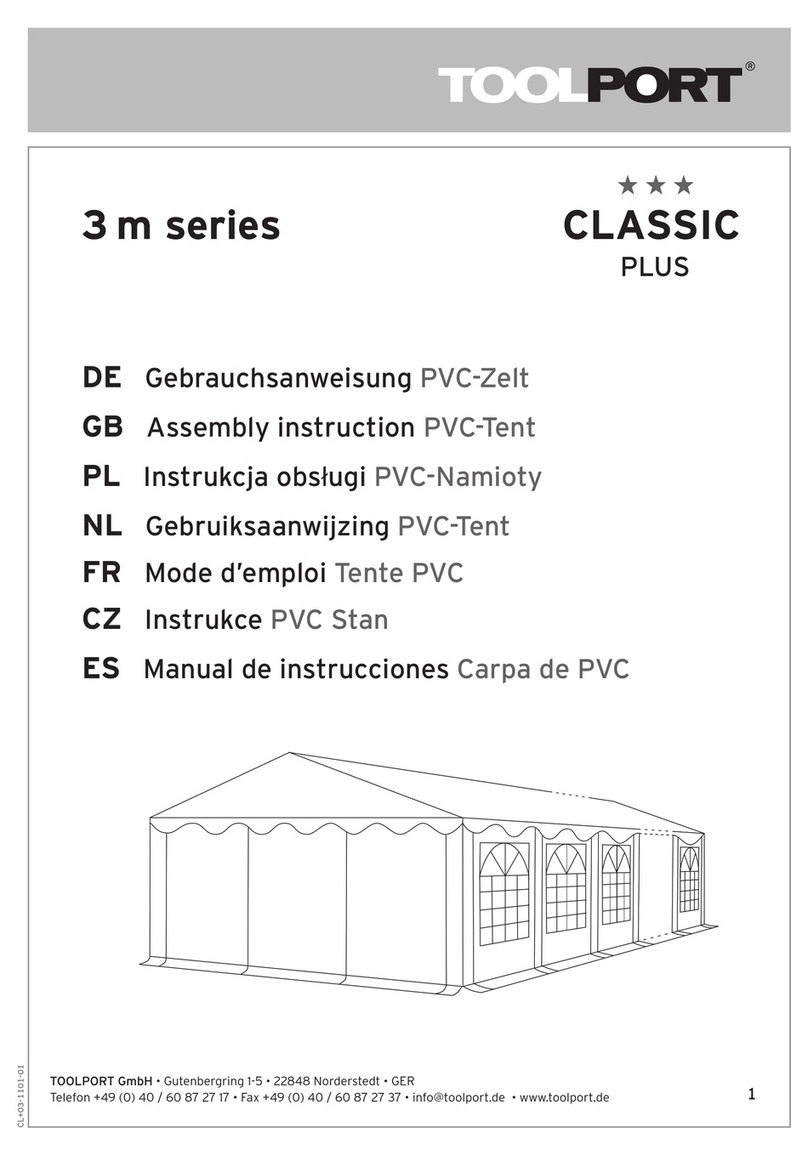
TOOLCRAFT
TOOLCRAFT 3 m Series Assembly instruction
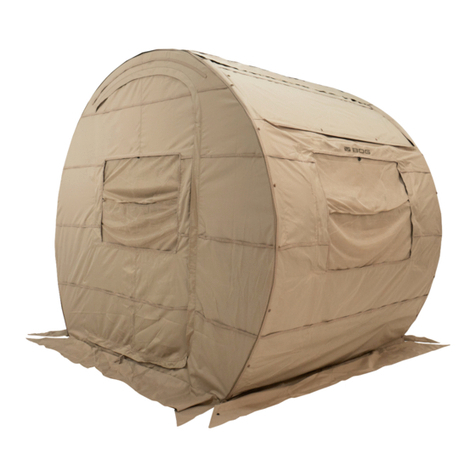
AOB
AOB BOG Circle of Death 1116634 instructions
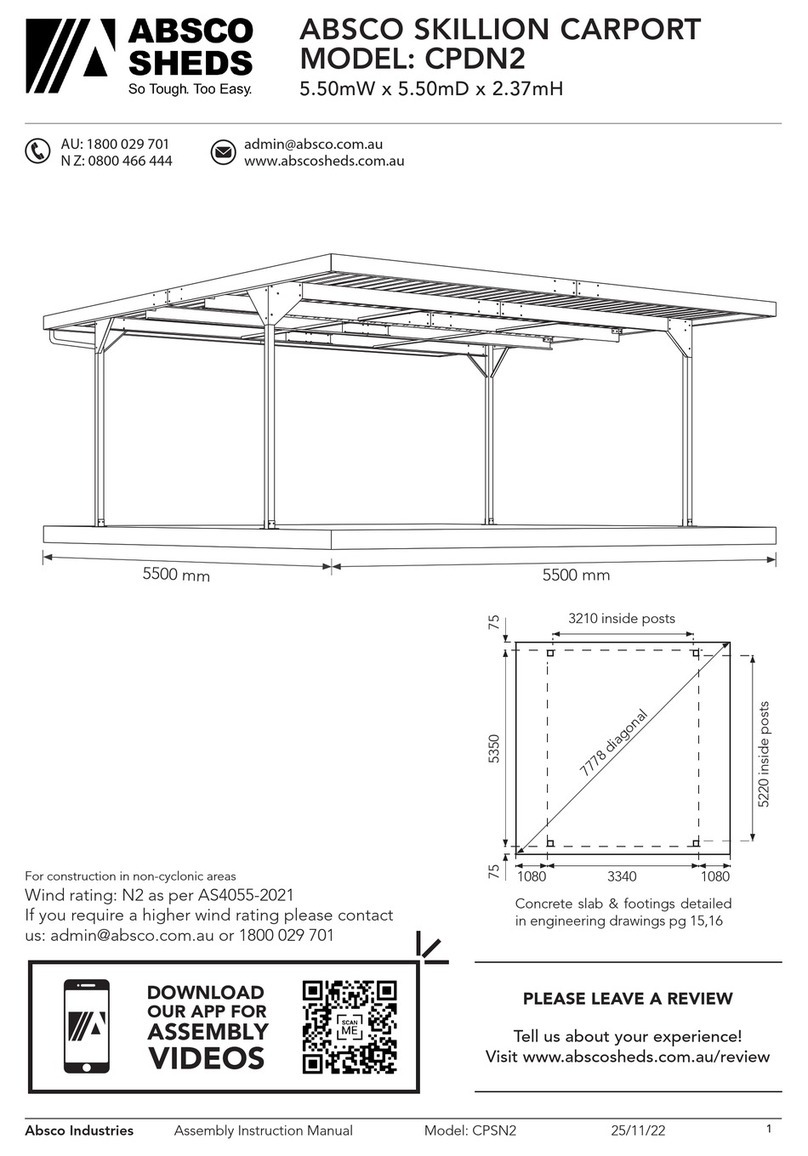
Absco Industries
Absco Industries SKILLION CPSN2 Assembly & instruction manual
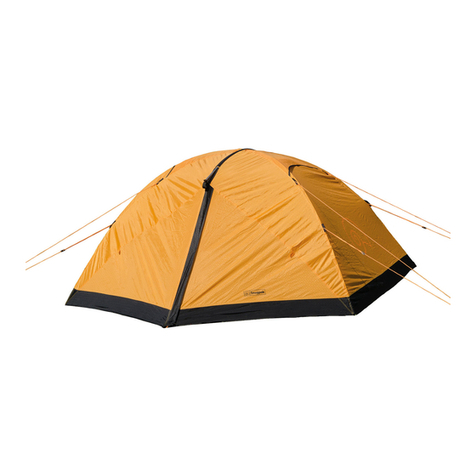
Snugpak
Snugpak JOURNEY TRIO Assembly instructions
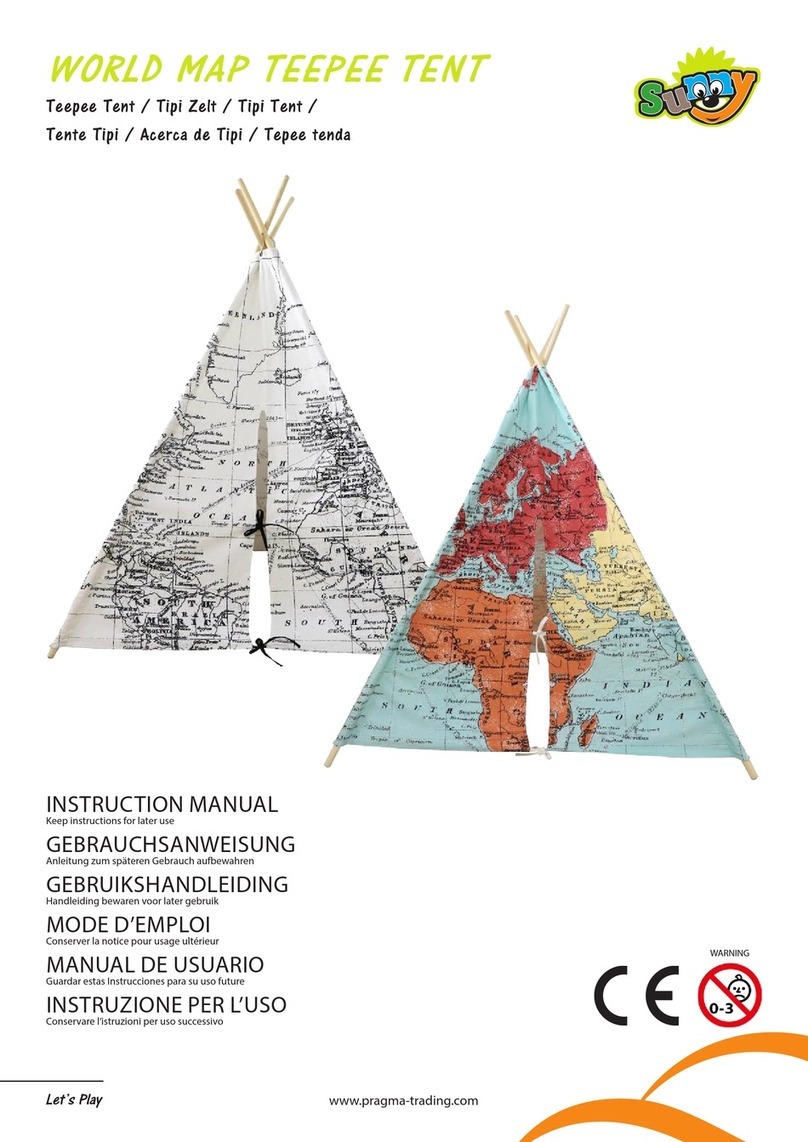
Pragma
Pragma Sunny WORLD MAP TEEPEE TENT instruction manual

mothercare
mothercare kids user guide
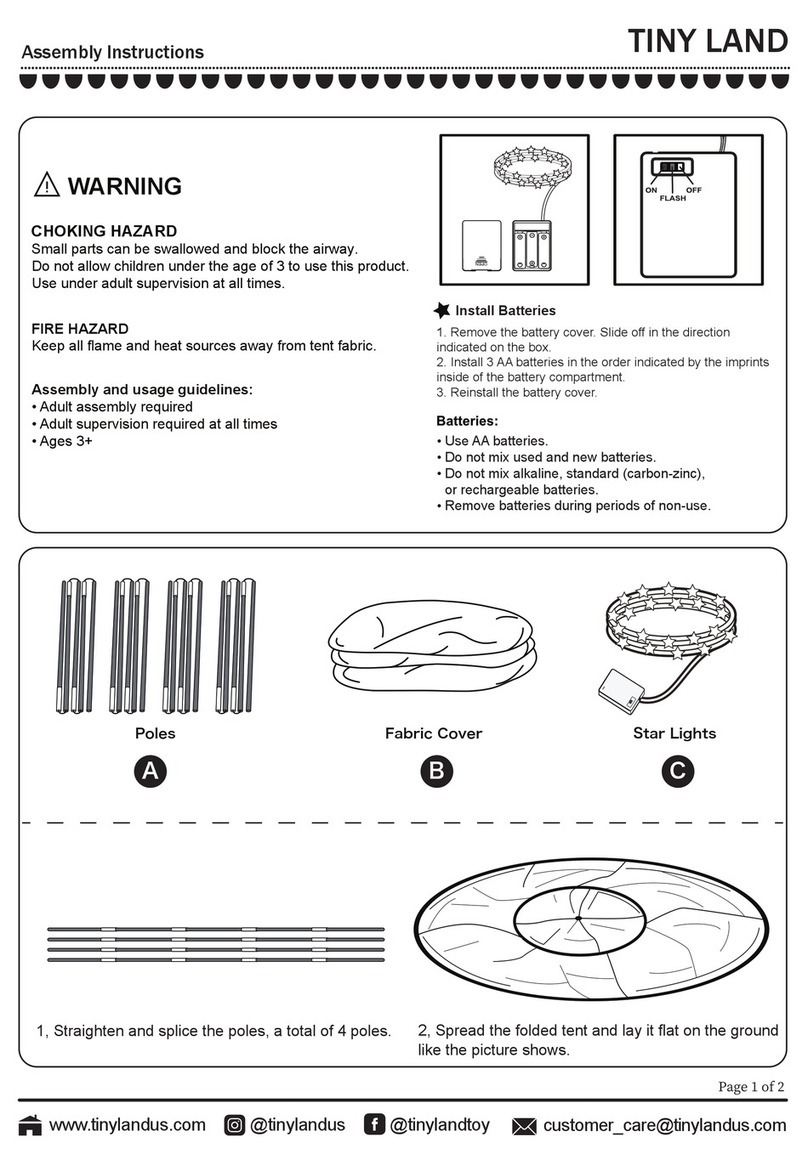
TINY LAND
TINY LAND Tent2004 Assembly instructions

Game Winner
Game Winner PL701GW instruction manual
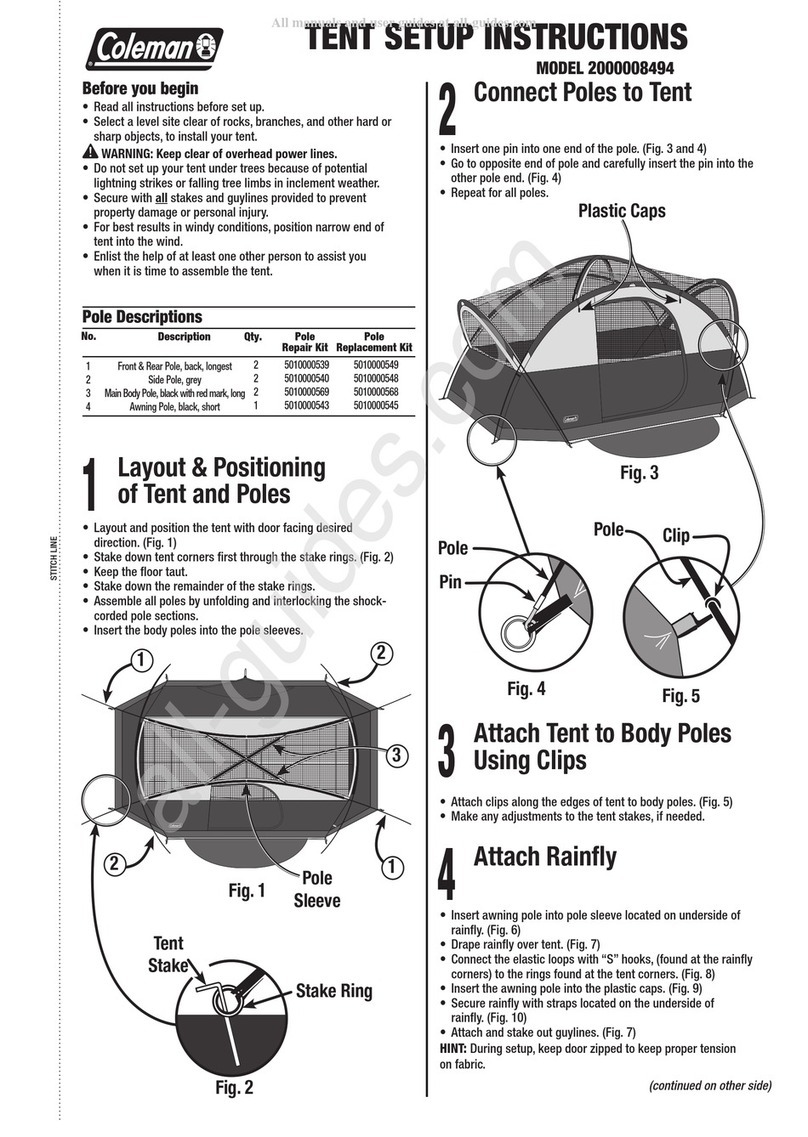
Coleman
Coleman 2000008494 Setup instructions
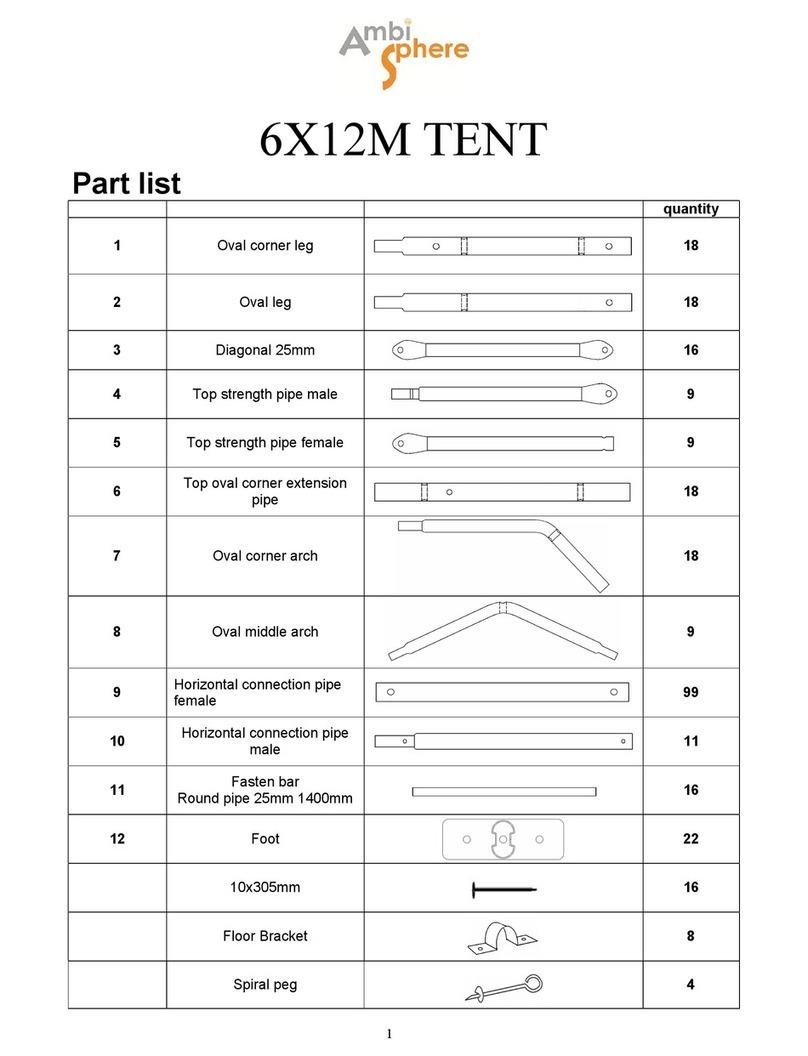
AMBI SPHERE
AMBI SPHERE Wikinger 6X12m quick start guide

skandika outdoor
skandika outdoor Esbjerg Travel 4 Setup Instruction

